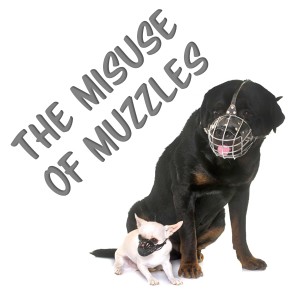 A muzzle is like a seat belt. It reduces injury but doesn’t prevent accidents.
A muzzle is like a seat belt. It reduces injury but doesn’t prevent accidents.
I have noticed a recent trend of the misuse of muzzles and the misunderstanding of their function in a behavior modification plan. No one puts on a seat belt and then suddenly drives carelessly. Yet, often times people put muzzles on their dogs and knowingly put them into situations they can’t cope without working on their behavioral issues systematically using a training plan.
The problem
The problem with just putting a muzzle on a dog and then putting him into situations where he is uncomfortable without training is that the dog will still be feeling and acting fearful, agitated or aggressive. He has not been given the skills to cope through training. If the dog were to bite, even though the dog can do less damage, it will still most likely be reinforcing to the dog. If a behavior is rehearsed, even if the dog has a muzzle on, the behavior will be more likely to happen in the future.
Not only is putting a dog unnecessarily into a situation that is too much for him unfair for that dog, but it is also unfair for the dogs that are exposed to that dog.
A dog acting fearful, over-aroused or aggressive in a muzzle is still as worrisome to other dogs. Being attacked or threatened by a dog in a muzzle can be just as traumatic for some dogs as sustaining injuries from being bitten.
The solution
DO continue to use muzzles! But create a behavior modification plan that sets the dog up so that he can cope every step of the way. Sure there will be times that your dog might get stressed, but the idea is to create a plan to prevent or reduce undue stress.
- Avoid unpredictable, crowded, stressful environments until your training is complete
- Avoid areas where other dogs are off leash
- Set up training sessions where you can train your dog and also be in control of the environment. For example, work with a calm decoy dog or person who will listen to you so you can create distance if needed or get closer as your dog succeeds to build his confidence without something unpredictable happening that might cause a set back.
- Train your dog to accept handling, grooming and restraint using Positive Reinforcement, so that when it is needed your dog will not be as stressed by it.
- Learn to read your dog’s body language for signs of undue stress. Different dogs exhibit different signs. Here are some examples: pinning ears back, becoming hyper vigilant, panting, dilated pupils, raised hackles, vocalizing, fearful or aggressive displays.
- Remove your dog from situations that are too stressful.
Train your dog to use a muzzle
It’s a great idea to teach every dog to feel comfortable wearing a muzzle. Emergencies can happen where your dog might suddenly need to be at the vet with an injury and might act unpredictably because of pain. Some countries require muzzles for public transportation. A muzzle is also a great piece of equipment to use for working with fear, reactivity and aggression in dogs. Where the dog is set up to succeed and the muzzle is just there in case of an unexpected emergency, like a seat belt.
Here is a video on how to condition a dog to feel comfortable wearing a muzzle:
https://www.youtube.com/watch?v=KJTucFnmAbw
Here is a link to Emily Larlham’s protocol for setting up a behavior modification plan:
https://dogmantics.com/protocol-for-emotional-and-behavioral-modification/
